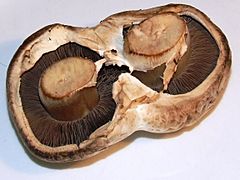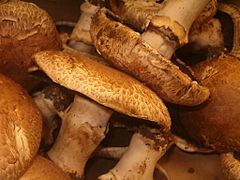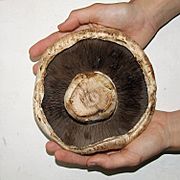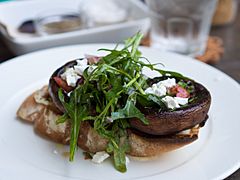Portobello mushroom facts for kids
Quick facts for kids Portobello mushroom |
|
|---|---|
 |
|
| Conservation status | |
| Scientific classification | |
| Synonyms | |
|
| Agaricus bisporus | |
|---|---|
| Mycological characteristics | |
| gills on hymenium | |
| cap is convex | |
| hymenium is free | |
| stipe has a ring | |
| spore print is brown | |
| ecology is saprotrophic | |
| edibility: choice | |
The Agaricus bisporus is a type of edible mushroom that grows naturally in grasslands. You can find it in Europe and North America. This mushroom is very popular around the world.
It comes in two main colors when it's young: white and brown. Both colors have different names. When the mushroom gets older, it also has special names. A. bisporus is grown in over seventy countries. It is one of the most eaten mushrooms globally.
Contents
Common Names for the Agaricus bisporus
This mushroom has many different names depending on its color and age.
When it is young and white, people call it the common mushroom or white mushroom. Other names include button mushroom, cultivated mushroom, table mushroom, or simply champignon.
When it is young and brown, it goes by names like Swiss brown mushroom or Italian brown mushroom. You might also hear it called cremini or baby bella. It is sometimes called chestnut mushroom, but this can be confusing as there is another mushroom with that name.
When the mushroom is fully grown, it turns brown. Its cap can be about 10 to 15 centimeters (4 to 6 inches) wide. This mature form is often sold as portobello mushroom.
How the Agaricus bisporus Got Its Name
The common mushroom has an interesting history of how it was named.
An English botanist, Mordecai Cubitt Cooke, first described it in 1871. He called it a type of Agaricus campestris. Later, in 1926, a Danish mushroom expert named Jakob Emanuel Lange looked at a special cultivated version. He named it Psalliota hortensis var. bispora.
In 1938, it became its own species and was called Psalliota bispora. Finally, in 1946, Emil Imbach gave it its current scientific name, Agaricus bisporus. This happened after the group of mushrooms called Psalliota was renamed Agaricus. The word bispora means "two-spored". This helps tell it apart from other types that have four spores.
What the Agaricus bisporus Looks Like
The wild version of this mushroom has a pale grey-brown cap. It has flat scales that fade towards the edges. When it's young, the cap is shaped like a half-sphere. As it gets older, it flattens out. The cap can be 5 to 10 centimeters (2 to 4 inches) wide.
The gills under the cap are narrow and close together. They are not attached to the stem. At first, they are pink, then turn red-brown, and finally dark brown. The stem is like a cylinder, about 6 centimeters (2.4 inches) tall and 1 to 2 centimeters (0.4 to 0.8 inches) wide. It has a thick ring around it.
The inside of the mushroom is white and firm. If you bruise it, it might turn a light pinkish-red. The spore print (the color of its spores) is dark brown. The spores are oval to round.
You can often find this mushroom all over the world. It grows in fields and grassy areas after it rains. This usually happens from late spring through autumn. It especially likes to grow near manure. Many people collect and eat this mushroom. However, it's very important to know that some poisonous mushrooms look similar.
Mushrooms That Look Like Agaricus bisporus
It's important to be careful when picking wild mushrooms. The common mushroom can look like some very dangerous ones.
One deadly mushroom that looks similar when young is the destroying angel. This mushroom is pure white and very poisonous. You can tell it apart because it has a cup-like structure at the base of its stem. Its gills are also pure white, not pinkish or brown like A. bisporus. Always check the base of the mushroom and cut it open to see the gills. The destroying angel also grows in mossy woods, not open fields.
Another common mistake is confusing A. bisporus with Agaricus xanthodermus. This mushroom is not deadly but can make you sick. It smells like phenol (a strong chemical smell). Its flesh turns yellow when you bruise it. This fungus can cause nausea and vomiting in some people.
The poisonous European mushroom Entoloma sinuatum also looks a bit like it. But this one has yellowish gills that turn pink, and it does not have a ring on its stem.
Growing Agaricus bisporus
People have been growing Agaricus bisporus for a long time. The first scientific description of how to grow it was in 1707 by a French botanist.
| Mushroom Production – 2019 | |
|---|---|
| Country | Millions of tonnes |
| 8.94 | |
| 0.47 | |
| 0.38 | |
| 0.36 | |
| 0.30 | |
| World | 11.90 |
| Source: FAOSTAT of the United Nations | |
In the past, growing mushrooms was tricky. Growers would find good patches of mushrooms in fields. Then, they would dig up the mushroom's underground network, called mycelia. They would replant these in beds of composted manure. But this often led to sick crops or no growth at all.
In 1893, a better way was found. The Pasteur Institute in Paris discovered how to grow "pure culture" spawn. This meant they could grow mushrooms on composted horse manure without getting them sick.
The first commercial Agaricus bisporus mushrooms were light brown. But in 1925, something special happened. A white mushroom was found growing among brown ones at a farm in Pennsylvania, USA. The farm owner, Louis Ferdinand Lambert, studied it. People liked the white mushroom because it looked more appealing. It became very popular and is now widely grown and sold. Most of the cream-colored mushrooms you see in stores today came from this natural change in 1925.
Today, A. bisporus is grown in at least seventy countries. In the U.S., the white button mushroom makes up about 90% of all mushrooms sold.
Nutritional Benefits of Agaricus bisporus
Mushrooms are good for you! A 100-gram serving of raw white mushrooms has about 93 kilojoules (22 calories).
They are an excellent source of several important B vitamins. These include riboflavin, niacin, and pantothenic acid. Fresh mushrooms are also a good source of the mineral phosphorus.
While fresh A. bisporus doesn't have much vitamin D, it can get a lot more if it's exposed to UV light. This makes them a great way to get more vitamin D!
Research on Agaricus bisporus
Scientists have studied some natural compounds found in mushrooms, like agaritine. These studies look at how these compounds might affect health. However, research shows that eating normal amounts of Agaricus bisporus mushrooms is safe for people.
Images for kids
See also
 In Spanish: Agaricus bisporus para niños
In Spanish: Agaricus bisporus para niños









